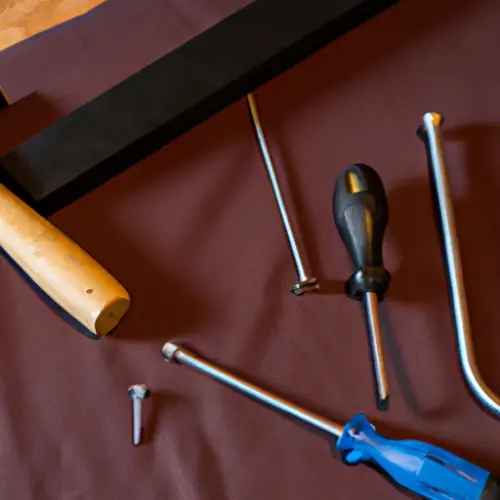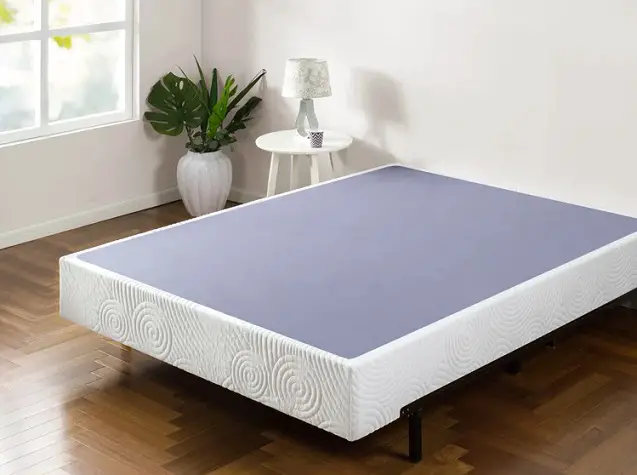If you have a futon frame that’s seen better days, fear not! In this article, I will share some valuable tips and tricks to help you revive your futon frame and bring it back to its former glory.
From simple repairs to creative solutions, I’ve got you covered. So, let’s roll up our sleeves and get ready to transform that tired old futon frame into a stylish and functional piece of furniture once again.

Table of Contents
Inspecting the Frame
When it comes to fixing a futon frame, the first step is to thoroughly inspect the entire structure. This will help you identify any issues and assess the level of repair needed. Start by checking for loose joints, as they are a common problem in futon frames.
Wiggle the frame gently to see if there is any movement or instability. If you feel any looseness in the joints, it’s important to address it promptly to prevent further damage.
Next, examine the metal parts of the frame. Look for any signs of rust, corrosion, or damage. Check if the metal bars are bent or misaligned. A bent metal bar can affect the stability and functionality of the futon frame.
Inspect the wood components for any cracks, splinters, or rotted sections. These issues not only compromise the structural integrity but also affect the overall appearance of the futon.
Fixing Loose Joints
Tightening screws and bolts is often the first line of defense when it comes to fixing loose joints in a futon frame. Grab a screwdriver or wrench and thoroughly tighten all the visible screws and bolts.
Ensure that they are snug and secure. If the joints are still loose even after tightening, consider using wood glue for reinforcement. Apply the wood glue to the joint, press the pieces together firmly, and let it dry according to the manufacturer’s instructions.
In some cases, the connectors in the frame may be worn-out and need replacement. These connectors are crucial for maintaining the stability of the futon frame. To replace them, carefully remove the old connectors and install new ones in their place.
Make sure to choose connectors that are compatible with your futon frame’s design and dimensions. This step will further strengthen the joints and ensure a sturdy frame.
Repairing Metal Parts
Straightening bent metal bars is essential for restoring the stability and functionality of a futon frame. Use a rubber mallet or a hammer to gently tap the bent part of the metal bar. Gradually straighten it until it aligns with the rest of the frame.
Take care not to use excessive force, as it may cause further damage to the metal. If the metal parts are severely damaged or broken, welding is a viable solution. Consult a professional welder to fix the broken parts and reinforce weak areas.
To prevent future issues, it’s important to apply rust prevention techniques to the metal parts of the futon frame. Start by scrubbing off any existing rust with a wire brush or sandpaper.
Then, apply a rust-resistant primer and a coat of paint specifically designed for metal surfaces. This will create a protective barrier and prevent rust from developing or spreading.
Addressing Wood Damage
Repairing cracks and splinters in the wood components of a futon frame is crucial for both aesthetics and functionality. Begin by cleaning the damaged area with a soft cloth or brush.
Fill any cracks with wood filler and smooth it out with a putty knife. Once the filler is dry, gently sand the repaired area to achieve a smooth finish. For splintered sections, carefully remove any loose wood and sand the area to prevent further splintering.
If the wood is rotted or severely damaged, it may be necessary to replace the affected sections. Measure the dimensions of the damaged wood and purchase replacement pieces of the same size and type.
Carefully remove the damaged sections and install the new ones in their place. Ensure a proper fit and secure the new pieces firmly to maintain the integrity of the futon frame.
To give your futon frame a fresh and renewed look, consider refinishing and sanding the wood components. Sand the entire frame with fine-grit sandpaper to remove the existing finish and create a smooth surface.
Then, apply a wood stain or paint of your choice. This will not only enhance the appearance of the futon frame but also provide an additional layer of protection.
Changing Futon Slats
Over time, the slats of a futon frame may become worn-out or damaged. Changing these slats is relatively straightforward and can significantly improve the comfort and durability of the futon. Start by measuring and cutting new slats to match the dimensions of the old ones. Use a saw or a similar cutting tool for this task.
To remove the old slats, carefully detach them from the frame. Depending on the design of your futon, this may involve removing screws or bolts. Once the old slats are removed, install the new ones in their place.
Make sure they are aligned properly and securely attached to the frame. When choosing the materials for the slats, opt for durable and sturdy options that can withstand frequent use.
Replacing Mattress Support
The support system of your futon mattress plays a vital role in maintaining its shape and providing comfortable sleep. If the old support system is worn-out or no longer effective, it’s important to replace it. Start by removing the old support system from the frame. This may involve unscrewing or unfastening specific parts.
Next, install a new support system that is compatible with your futon frame. Make sure to follow the manufacturer’s instructions carefully during installation. The new support system should evenly distribute the weight of the mattress and provide optimal support. This will prevent sagging and prolong the lifespan of your futon mattress.
In addition to proper installation, it’s crucial to ensure proper weight distribution on the futon frame. Avoid placing excessive weight on a single area or using the futon for purposes beyond its intended capacity. This will help maintain the integrity of the frame and prevent future damage.
Dealing with Worn-out Upholstery
Upholstery tears and rips can greatly diminish the appearance and comfort of a futon. Fortunately, there are ways to repair or replace the upholstery, depending on the extent of the damage. For small tears and rips, use a fabric repair kit to mend the damaged area. Follow the instructions provided with the kit to ensure a proper repair.
If the upholstery is severely damaged or you simply want a fresh look, consider replacing it altogether. Remove the old upholstery by carefully detaching it from the frame. Once the old upholstery is removed, measure the dimensions of the futon and purchase a new upholstery cover that fits properly. Install the new upholstery cover according to the manufacturer’s instructions.
To keep the upholstery clean and well-maintained, regularly vacuum it to remove any dust or debris. If spills or stains occur, promptly clean them with a mild detergent or an upholstery cleaner suitable for the fabric type. Regular maintenance will not only enhance the appearance of your futon but also prolong its lifespan.
Enhancing Comfort and Durability
To maximize the comfort and durability of your futon, consider adding extra cushioning to the seat and backrest. This can easily be accomplished by using foam or padding. Measure the dimensions of the seat and backrest, and cut the foam or padding accordingly.
Place it on top of the existing cushioning, and cover it with the upholstery. This will provide added comfort and support for a more enjoyable lounging experience.
If your futon mattress is not as comfortable as it once was, adding a mattress topper can provide an instant upgrade. Look for a mattress topper that is designed for futon use and provides the desired level of comfort.
Simply place the mattress topper on top of the existing mattress and secure it with straps or velcro. This will improve the overall comfort of your futon and extend the lifespan of the mattress.
To further enhance the durability of your futon frame, consider adding reinforcements to critical areas prone to wear and tear. This can include additional screws or brackets to provide extra support. Reinforcing the frame in this manner will extend its lifespan and ensure that it can withstand regular use for years to come.
Optimizing Futon Adjustability
To ensure that your futon is easy to use and adjust, it’s important to maintain and optimize its hinges and mechanisms. Lubricate the hinges with a suitable lubricant to prevent them from becoming stiff or squeaky. This will make it easier to convert the futon from a sitting position to a sleeping position and vice versa.
If you encounter any issues with stuck or misaligned conversion parts, carefully inspect them for any debris or obstructions. Remove any dirt or objects that may be preventing smooth operation.
In more severe cases, you may need to take the futon apart and realign the conversion parts properly. This will ensure that the futon operates smoothly and effortlessly.
Maintaining and Preventing Future Issues
To keep your futon frame in optimal condition and prevent future issues, regular cleaning and dusting are crucial. Use a soft cloth or brush to remove any dust or dirt from the frame. Pay close attention to the joints and corners, as they tend to accumulate more dust. Periodically vacuum the upholstery to remove any debris or allergens that may have settled on it.
To protect the frame from wear and tear, apply a protective finish such as varnish or sealant. This will create a barrier that shields the wood from moisture, scratches, and fading. Follow the manufacturer’s instructions when applying the protective finish and allow it to dry thoroughly before using the futon.
It’s also important to prevent excessive weight and rough use on the futon frame. Avoid jumping or standing on the futon as this can cause damage to the frame. Additionally, be mindful of the weight capacity specified by the manufacturer and avoid exceeding it.
By practicing these preventative measures, you can prolong the lifespan of your futon frame and minimize the need for repairs. In conclusion, fixing a futon frame requires a comprehensive approach that addresses various aspects of repair and maintenance.
By inspecting the frame, fixing loose joints, repairing metal parts, addressing wood damage, replacing slats and mattress support, dealing with worn-out upholstery, enhancing comfort and durability, optimizing adjustability, and maintaining and preventing future issues, you can revive your futon frame and enjoy its comfort and functionality for years to come.


